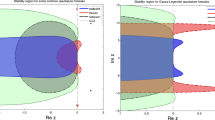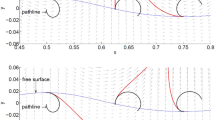Abstract
We propose a new class of Lagrangian approaches for constructing the flow maps of given dynamical systems. In the case when only discrete velocity data at mesh points is available, an interpolation step will be required. However, in our proposed approaches all particle trajectories share a common global interpolation at each time step and therefore interpolation operations will not increase the overall computational complexity. The old Lagrangian approaches propose to solve the corresponding ordinary differential equations (ODEs) backward in time to obtain the backward flow map. It is inconvenient and not natural, especially when incorporated with certain computational fluid dynamic solvers, because the velocity field needs to be loaded from the terminal time backward to the initial time. In contrast, our proposed approaches for computing the backward flow map propose to solve the corresponding ODEs forward in time which is more practical. We will also extend the proposed approaches to compute line integrals along any particle trajectory. This paper gives a detailed analysis on the computational complexity and error estimate of the proposed Lagrangian approach. Finally, a wide range of applications of our approaches will be given, including the so-called coherent ergodic partition and the high frequency wave propagations based on geometric optic.









Similar content being viewed by others
References
Allshouse, M.R., Peacock, T.: Lagrangian based methods for coherent structure detection. Chaos 25(9), 097617 (2015)
Artale, V., Boffetta, G., Celani, A., Cencini, M., Vulpiani, A.: Dispersion of passive tracers in closed basins: Beyond the diffusion coefficient. Phys. Fluids 9(11), 3162–3171 (1997)
Aurell, E., Boffetta, G., Crisanti, A., Paladin, G., Vulpiani, A.: Predictability in the large: an extension of the concept of Lyapunov exponent. J. Phys. A: Math. Gen. 30, 1–26 (1997)
Besse, N., Mehrenberger, M.: Convergence of classes of high-order semi-Lagrangian schemes for the Vlasov–Poisson system. Math. Comput. 77(261), 93–123 (2008)
Brunton, S.L., Rowley, C.W.: Fast computation of finite-time Lyapunov exponent fields for unsteady flows. Chaos 20, 017503 (2010)
Candès, E.J., Ying, L.: Fast geodesics computation with the phase flow method. J. Comput. Phys. 220, 6–18 (2006)
Cencini, M., Vulpiani, A.: Finite size Lyapunov exponent: review on applications. J. Phys. A: Math. Theor. 46, 254019 (2013)
Cerveny, V., Molotkov, I.A., Psencik, I.: Ray Method in Seismology. Univerzita Karlova Press, Karlova (1977)
Enright, D., Losasso, F., Fedkiw, R.: A fast and accurate semi-Lagrangian particle level set method. Compt. Struct. 83, 479–490 (2005)
Farazmand, M., Haller, G.: Computing Lagrangian coherent structures from their variational theory. Chaos 22, 1–12 (2012)
Guo, H., He, W., Peterka, T., Shen, H.-W., Collis, S.M., Helmus, J.J.: Finite-time Lyapunov exponents and Lagrangian coherent structures in uncertain unsteady flows. IEEE Trans. Vis. Comput. Graph. 22(6), 1672–2016 (2016)
Haller, G.: Distinguished material surfaces and coherent structures in three-dimensional fluid flows. Phys. D 149, 248–277 (2001)
Haller, G.: Lagrangian structures and the rate of strain in a partition of two-dimensional turbulence. Phys. Fluids A 13, 3368–3385 (2001)
Haller, G., Yuan, G.: Lagrangian coherent structures and mixing in two-dimensional turbulence. Phys. D 147, 352–370 (2000)
Hermandez-Carrasco, I., Lopex, C., Hernansez-Garcia, E., Turiel, A.: How reliable are finite-size Lyapunov exponents for the assessment of ocean dynamics? Ocean Model. 36(3–4), 208–218 (2011)
Lekien, F., Shadden, S.C., Marsden, J.E.: Lagrangian coherent structures in \(n\)-dimensional systems. J. Math. Phys. 48, 065404 (2007)
Letz, T., Kantz, H.: Characterization of sensitivity to finite perturbations. Phys. Rev. E. 61, 2533 (2000)
Leung, S.: An Eulerian approach for computing the finite time Lyapunov exponent. J. Comput. Phys. 230, 3500–3524 (2011)
Leung, S.: The backward phase flow method for the finite time Lyapunov exponent computations. Chaos 23, 043132 (2013)
Leung, S., Qian, J.: Transmission traveltime tomography based on paraxial liouville equations and level set formulations. Inverse Probl. 23, 799–821 (2007)
Leung, S., Qian, J.: Eulerian Gaussian beams for Schrödinger equations in the semi-classical regime. J. Comput. Phys. 228, 2951–2977 (2009)
Leung, S., Qian, J.: The backward phase flow and FBI-transform-based Eulerian Gaussian beams for the Schrödinger equation. J. Comput. Phys. 229, 8888–8917 (2010)
Leung, S., Qian, J., Burridge, R.: Eulerian Gaussian beams for high frequency wave propagation. Geophysics 72, SM61–SM76 (2007)
Mills, P.: Following the Vapour Trail: A Study of Chaotic Mixing of Water Vapour in the Upper Troposphere. Thesis, University of Breman, Germany (2004)
Mills, P.: Isoline retrieval: an optimal sounding method for validation of advected contours. Comput. Geosci. 35, 2020–2031 (2009)
Osher, S.J., Fedkiw, R.P.: Level Set Methods and Dynamic Implicit Surfaces. Springer, New York (2003)
Osher, S.J., Sethian, J.A.: Fronts propagating with curvature dependent speed: algorithms based on Hamilton–Jacobi formulations. J. Comput. Phys. 79, 12–49 (1988)
Osher, S.J., Shu, C.W.: High-order essentially nonoscillatory schemes for Hamilton–Jacobi equations. SIAM J. Num. Anal. 28, 907–922 (1991)
Runge, C.: Uber empirische funktionen und die interpolation zwischen aquidistanten ordinaten. Z. Math. Phys. 46, 224–243 (1901)
Sethian, J.A.: Level Set Methods. Cambridge University Press, Cambridge (1996)
Shadden, S.C., Lekien, F., Marsden, J.E.: Definition and properties of Lagrangian coherent structures from finite-time Lyapunov exponents in two-dimensional aperiodic flows. Phys. D 212, 271–304 (2005)
Staniforth, A., Cote, J.: Semi-Lagrangian integration schemes for atmospheric model—a review. Mon. Weather Rev. 119, 2206–2223 (1991)
Ying, L., Candès, E.J.: The phase flow method. J. Comput. Phys. 220, 184–215 (2006)
You, G., Leung, S.: An Eulerian method for computing the coherent ergodic partition of continuous dynamical systems. J. Comput. Phys. 264, 112–132 (2014)
Acknowledgements
The work of You was supported by the National Natural Science Foundation of China (Grant No. 11701287) and the Natural Science Foundation of Jiangsu Province (Grant No. BK20171071). The work of Shi was supported by the Natural Science Foundation of Jiangsu Province (Grant No. BK20160856). The work of Xu was supported by the National Natural Science Foundation of China (Grant No. 61673221).
Author information
Authors and Affiliations
Corresponding author
Rights and permissions
About this article
Cite this article
You, G., Shi, R. & Xu, Y. An Efficient Lagrangian Interpolation Scheme for Computing Flow Maps and Line Integrals using Discrete Velocity Data. J Sci Comput 76, 120–144 (2018). https://doi.org/10.1007/s10915-017-0620-7
Received:
Revised:
Accepted:
Published:
Issue Date:
DOI: https://doi.org/10.1007/s10915-017-0620-7




